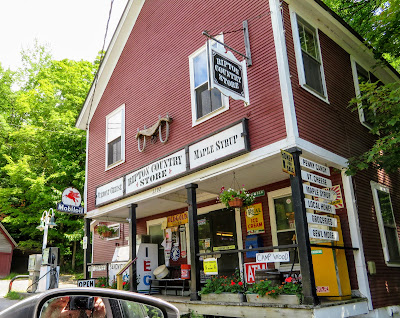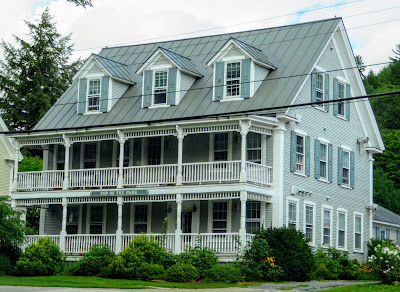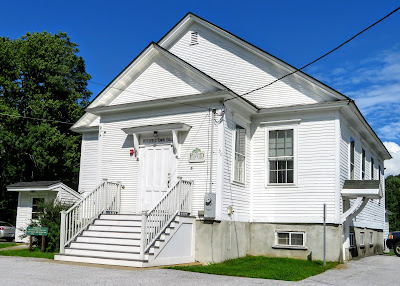…continuing
with our August 2018 adventures in the northeastern USA.
After our
first night in Rutland Vermont, we were off to the first of our 2 attractions
for the day…
Along the
way, we passed the well-known ski slopes at Killington Vermont. The Killington Mountain Resort and Ski Area
is the largest ski area in the eastern USA.
It also has the largest vertical drop in New England at 3,050 feet. Its nickname is the “Beast of the East”.
For more
information about the Killington Ski Area, you can go to https://www.killington.com/. Snow and winter cold are not for us! We do enjoy watching others suffer in the
north country…as we did as well for most of our lives!
The
scenery as we approached our destination was peaceful, green and
beautiful. We couldn’t have asked for a
nicer day!
This is
Calvin Coolidge Museum and Educational Center at Plymouth Notch Vermont. The Plymouth Notch Historic District is the
birthplace (July 4, 1872) and boyhood home of Calvin Coolidge, the 30th
President of the United States. This
National Historic Landmark is owned and operated by the Vermont Division for
Historic Preservation.
The
museum and education center was built in 1972 by the State of Vermont for the
centennial of President Coolidge’s birth.
It was expanded in 2010. In
addition to serving as the Visitor’s Center, the building has meeting rooms, a
gift shop, restrooms, offices, a research library and of course, an exhibit
that explores Calvin Coolidge’s career including his presidency.
This
painting of Calvin Coolidge is one of the many items on display in the museum
at the Visitor’s Center.
Calvin
Coolidge was a Republican lawyer. He
moved from Vermont to Massachusetts and worked his way up the ladder in state
politics, eventually becoming governor.
His response to the Boston Police Strike of 1919 gave him the reputation
of being a man of decisive action. In
1920, he was elected Vice President of the United States with Warren G. Harding
as President.
To learn
about the bloody Boston Police Strike and its aftermath, go to https://en.wikipedia.org/wiki/Boston_Police_Strike.
This photo is of an Native American headdress that
was given to President Coolidge. It was given to him on 7/23/17 at Fort Yates North Dakota. The President was presented with this ceremonial feathered headdress by Sioux Chief Standing
Bear and he was officially declared an honorary tribal member.
I tried to attach a photo from the Internet of a decidedly uncomfortable President Coolidge with his headdress, but I couldn't figure out how to move the photo to the blog site. You can see several photos of the President in his headdress at https://www.bing.com/images/search?q=president+coolidge+headdress&qpvt=President+Coolidege+headdress&FORM=IGRE and the video at https://www.youtube.com/watch?v=t54xMnsuhmQ is even more amusing.
Coolidge’s
public policy toward Native Americans included the Indian Citizen Act of 1924,
which granted automatic US citizenship to all American tribes. On personal moral grounds, he regretted the
state of poverty that many tribes were experiencing after decades of legal
persecution and forced assimilation. (Little changed though…as forced assimilation
as a policy continued for many years)
There was
a wide variety of memorabilia on exhibit in the museum…far too many for me to
try to show in this post. Many strange
and sometimes wonderful gifts are given to Presidents. This elaborately carved chair with tooled
leather was given to President Coolidge in 1928 to commemorate the warm
relations between the USA and Hungary.
Hungary’s Day of Independence is the same as ours in the USA…July 4th.
Another
item on exhibit in the Coolidge Museum is this desk that belonged to Chester A.
Arthur, the 21st President of the United States and the only other President
that came from Vermont. Both Arthur and
Coolidge left Vermont and gained political prominence elsewhere. I don’t remember why this desk is on exhibit
at the Coolidge Museum.
Plymouth
Notch is virtually unchanged since the early 1900s. The buildings have been preserved and many of
the buildings even have their original furnishings.
The
Florence Cilley General Store was built in the 1850s. John Coolidge, father of the future
President, became storekeeper here in 1868.
By 1875, he bought the store.
Later he sold the business but retained the building. He sold it to Florence Cilley in 1917. The small post office (sign at the far left)
served Plymouth Notch until 1976.
The first
floor of the Cilley Store is stocked with all types of old-fashioned sweets,
Vermont-made jams, jellies, spreads, maple syrup, homemade fudge and
brittles. Lots of other items are
offered too…including ornamental tiles, cast iron doorstops, jewelry, felting
kits, sleigh bells and much more!
Historically
speaking the second floor of the General Store is more significant. Coolidge Hall, this large vaulted room above
the store, was used by the Grange for weekly dances and family reunions well
into the 1900s.
This second floor room gained fame in 1924
when it served as President Coolidge’s Summer White House office in 1924. The hall has its original furnishings which
included tables made especially for the President. Note the musical instruments in the back left
from the “Plymouth Old-Time Dance Orchestra".
Calvin
Coolidge’s birthplace is attached to the back of the General Store. The first child of John Calvin and Victoria
Josephine Moor Coolidge was born in the downstairs bedroom. The family lived in this house until 1876
when they moved across the street to the home that is now called the Coolidge
Homestead.
Unlike
the other buildings in town, the Coolidge birthplace had been extensively
remodeled over time. The Vermont
Division for Historic Preservation bought it in 1968 and they restored it to
its 1872 appearance.
The
Coolidge family donated the original furnishings in the home. John Calvin Coolidge III and his wife helped
start the Coolidge Foundation and their gift of buildings, land and artifacts
were critical in the creation of the President Calvin Coolidge State Historic
Site. John III died in 2000, but well
into his 80s he was frequently seen going from his home to the post office to
collect his mail.
This is
the Coolidge Homestead, the boyhood home of Calvin Coolidge. The family moved into this home when
Calvin was 4 years old. His chores
included filling the wood box and caring for the animals. Free time was often spent visiting his grandparents
in their home across the pasture behind the homestead.
John
Calvin Coolidge, Calvin’s father, was born in Plymouth Notch. He lived in this house until he died in
1926. In addition to being a farmer and
store owner, he also was a banker, insurance broker, member of the State House
of Representatives, State Senator, veteran of the Vermont militia, town
constable, county deputy sheriff and notary public.
John’s
housekeeper Aurora lived in the Coolidge homestead for another 30
years…rejecting the easy life of electricity and indoor plumbing, so the house
remained as it was back in 1923. It
certainly wasn’t a fancy ‘modern’ kitchen, even for the 1920s…
This parlor or living room was witness to an important part of US History. Vice President Coolidge was vacationing here at his old family home in August of 1923, when he received an urgent message that President Warren G. Harding had died. In the middle of the night, in this very room, Calvin Coolidge was sworn in as President by his father, the local notary public.
The story
goes that when President Harding died, a phone call was made to the post office
to inform Coolidge of the fact. However,
the postmistress/store owner was afraid of the newfangled gadget so she didn’t
answer it. The message was delivered by
a messenger who drove to the village. Later,
when a visitor asked John Coolidge how he knew he could administer the
presidential oath to his son, his comment was “I didn’t know that I couldn’t.”
Note:
- A bit about Calvin Coolidge, our 30th President. Nicknamed “Silent Cal” for his quiet, steady and frugal nature, he cleaned up the rampant corruption of the Harding Administration and provided a model of stability in the fast-paced roaring 20s. He was pro-business and he favored tax cuts and limited government spending. However, some of his ‘hands off’ policies later contributed to the economics issues leading to the Great Depression. He was re-elected in 1924 but declined to run again in 1928 although many thought that he could have won another term in office.
The
Plymouth Cheese Factory was built by John Coolidge and 4 other local farmers in
1890. It provided a convenient way for
them to market the milk produced on area farms.
The operation closed down in 1934, but the President’s son, John III,
reopened it in 1960. The Vermont
Division for Historic Preservation bought it from him in 1998, upgrading it to
meet today’s requirements while preserving its historic character.
These
photos show the inside of the Plymouth Cheese Factory with the store in the first photo and the cheese making in the second. Of course, there was another opportunity for
shoppers and visitors can watch workers engaged in the cheese-making
process. The Plymouth Cheese Factory is
the second oldest cheese factory in the United States.
Good news
for cheese lovers and on-line shoppers!
Check out the Plymouth Cheese Factory’s offerings at https://www.plymouthartisancheese.com/.
The Greek
revival style Union Christian Church was built in 1840. Even the iron thresholds for the front doors
were cast in a local iron furnace. Over
the years, repairs were needed. In the
1890s, strawberry socials and baked bean suppers were held to raise funds for
the needed work.
The
Church is owned by the Calvin Coolidge Memorial Foundation. This non-profit perpetuates the memory of the
President through educational programs and publications. To learn more about this organization, you
can go to https://www.coolidgefoundation.org/.
A local
artisan then redesigned the interior of the church in the Carpenter Gothic
style. The woodwork and patterns are
both beautiful and amazing! The hard
pine for the woodwork was sawn locally.
The interior offered perfect acoustics for the new pump organ and the
church was rededicated in 1900.
This is
the Wilder House. Originally it was
built in 1830 and it served as a tavern.
It was the childhood home of President Coolidge’s mother, Victoria
Josephine Moor. She married Calvin’s
father in the front sitting room of the home.
Her sister and brother-in-law, Gratia and John Wilder, lived in the
house in later years.
The house
is painted as it was in the 1920s…with that mustard-gold and green color
scheme. In 1956, the interior was
remodeled and the home now serves as the restaurant for the State Historic
Site. Breakfast and lunch are served
during the season…
Note:
· Despite his nickname, “Silent Cal” made good
use of the new medium of radio. His
second inauguration was the first such event to be broadcast on radio. He met with reporters more times than any
other President, then or now, with 520 press conferences!
The
Wilder Horse Barn was reconstructed in 2003.
It’s a recreation of the original ca. 1875 barn that was torn down in
the mid-2000s.
For the
sake of at least some brevity, I haven’t pictured or discussed several other
buildings or features in this historic complex.
These include the Coolidge Farm Shop, the Carrie Brown Coolidge Garden,
the Wilder Bank Barn, The Aldrich House, the Top of the Notch Cabins or the
One-Room Schoolhouse.
…but back
to some of the items on display in the Horse Barn.
This is a
1923 Ford Model “T” Tudor Sedan. At the
time it was built, it cost about $580.00.
This is a
Rural Free Delivery Sleigh that was used to deliver mail during the winters in
the 1920’s and 1930s. It was equipped
with a small stove that provided a modicum of heat. The shafts are offset so the horses can walk
in the runner tracks left by previous sleighs.
I didn’t
know that back in the early days mail carriers had to buy their own carriages
or wagons and they had to purchase and care for their own horses!
This is
referred to as a “Summer Hearse”. It was
built ca. 1885 in New Bedford Massachusetts and it was in use until about
1920.
This is
the “Flying Eagle” (Unit #348). This
Concord coach was built ca. 1850 in the hotel or city style. (Based on the windows)
Concord coaches were superior to other wagons due to their suspension system…which
was called a “thoroughbrace”. They could
really handle the rough roads of the time.
This
coast was once used on the mail run between Woodstock and Reading Vermont. Later in its career, it served to carry
guests from the Woodstock Railway Station to the Woodstock Inn. It operated well into the early 2000s.
This is
the Plymouth Cemetery… This hillside cemetery was established sometime prior to
1800. It’s under the care of the
Plymouth Cemetery Commissioners who are elected at the annual town meeting.
So why
did I include a photo of a country cemetery?
President
Calvin Coolidge and his family, actually 7 generations of the Coolidge family,
are buried here. Some visitors are
reported to express surprise that a President of the United States is buried in
such a simple fashion in a country cemetery.
When Calvin Coolidge left the White House, he said, “We draw our
Presidents from the people…I came from them.”
Here are
a few famous quotes from President Calvin Coolidge:
· Collecting more taxes than are absolutely
necessary is legalized robbery.
· I have never been hurt by what I have not
said.
· Don’t expect to build up the weak by pulling
down the strong.
· All growth depends upon activity. There is no development physically or
intellectually without effort, and effort means work.
Not only
did we enjoy the history of this place, Laurie and I also thought that it was
one of the prettiest places we’ve visited.
To learn more about the President Calvin Coolidge State Historic Site at
Plymouth Notch Vermont, you can just go to https://historicsites.vermont.gov/directory/coolidge.
For more
information about Calvin Coolidge, his life, politics, accomplishments and
miscues, check out a bit of history at https://en.wikipedia.org/wiki/Calvin_Coolidge.
Just
click on any of the photos to enlarge them…
Take
Care, Big Daddy Dave

































































